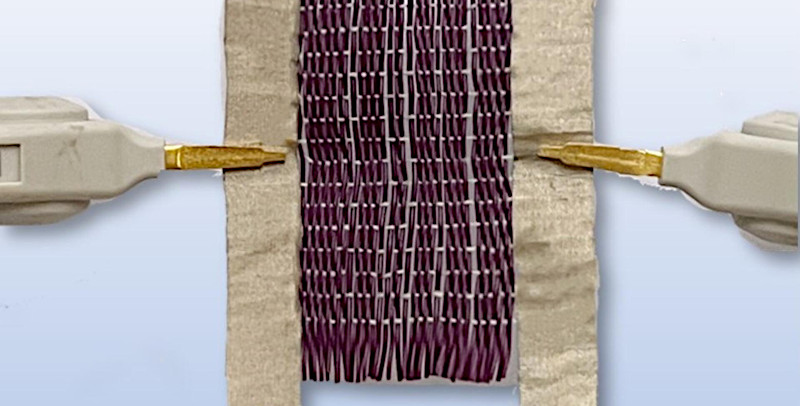
UWaterloo-developed smart fabric responds to temperature and electricity
By DE Staff
Automation Materials Automotive MedicalResearchers say programmable fabric the first that activates in response to two different stimuli.

University of Waterloo’s multi-stimuli-responsive material changes color and shape when exposed to heat or electricity.
(Photo credit: University of Waterloo)
Researchers at the University of Waterloo announced the development of a smart material that is activated by both heat and electricity, making it the first to respond to two different stimuli. Composed of polymer nano-composite fibres from recycled plastic and strands of stainless steel, the programmable fabric can change its colour and shape when stimuli are applied.
According to the development team, the fabric opens a variety of applications, including clothing that warms up in response to cold temperatures and vehicle bumpers that return to their original shape after a collision.
“As a wearable material alone, it has almost infinite potential in AI, robotics and virtual reality games and experiences,” said UWaterloo chemical engineering professor, Dr. Milad Kamkar, who also serves as director of the Multi-scale Materials Design (MMD) Centre at Waterloo. “Imagine feeling warmth or a physical trigger eliciting a more in-depth adventure in the virtual world.”
Technically speaking, the Waterloo smart material melds two types of stimuli-responsive materials (SRMs): Shape memory polymers (SMPs) – which have a permanent and a temporary shape depending on a specific stimuli – and Thermochromic colorants (TCCs) – which change color based on temperature.
Employing a melt-spinning process, the UWaterloo team formed metallic composite yarns and thermochromic fibers. Weaving them together allowed the researchers to compose a multi-responsive smart-fabric that transforms from a predefined structure to its original shape while also changing color when exposed to heating or an electric field.
The researchers also created a device similar to a traditional loom, they say allows the fabric’s shape and color change to be ‘programmed’ by controlling the micro-scale design of the fabric’s individual fibers. As a result, parts of the fabric can be locally activated by applying a controlled voltage to any part of the fabric.
In addition to its programmability, the smart fabric needs only 5V to activate, less than other smart fabrics. In addition to improved energy efficiency, this lower voltage requirement makes the material suitable for smaller, more portable devices, including biomedical devices and environment sensors.
The researchers say the next step will be to improve the fabric’s shape-memory performance with the aim of constructing a robot that can carry and transfer weight. A paper on the research, Multi-Stimuli Dually-Responsive Intelligent Woven Structures with Local Programmability for Biomimetic Applications, recently appeared in the journal Nano-Micro Small.
https://uwaterloo.ca
